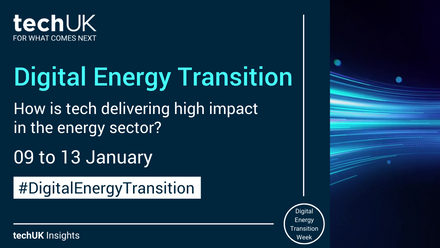Event round-up: Digital transformation: Unlocking value at the Edge of the Cloud
On 15 July, techUK hosted a webinar bringing together industry leaders to explore the convergence of Cloud and Edge in 2022 and beyond.
The panel included:
- Stephen Green, Chief Technology Officer, NTT Ltd
- Marcus Bonner, Chief Technologist - Manufacturing, Travel & Transport, HPE
- Giulia Merlo, Edge Computing Global Portfolio Senior Manager, Vodafone
- Annika Garbers, Product Manager, Cloudflare
- Laura Foster, Head of Tech & Innovation at techUK (Chair)
Laura opened the session by asking the panel how they see cloud and edge converging to enable digital transformation.
Marcus suggested the key trend is that organisations are moving compute closer to data and that overwhelmingly that is occurring at the edge. Businesses want to manage and process data using cloud capabilities that have been built up by hyperscalers but do so at the edge to add value.
Stephen agreed that many businesses are on a journey to becoming digital organisations, and that means expanding the modernisation that began in data centres, with virtualisation and software defined networking, out beyond the IT core and into a multi-cloud hybrid environment, harnessing the power of 5G and edge computing to drive business value with real-time data.
Annika described the network architecture journey that many businesses have been on in recent years and the expansion of the core data centre to the edge - including storage, compute, networking and security functions - all delivering better performance for users.
The panel explored the rise of edge-native applications built specifically for edge computing and taking advantage of the capabilities offered by cloud platforms. This enables organisations to deploy new functionality very quickly to clients and is accelerating modernisation of legacy IT.
Giulia agreed that we are seeing a big drive for more distributed computing capabilities closer to customers to enable real-time insights and faster decision-making, highlighting the automotive sector and the development of autonomous vehicles as a key edge computing use-case.
The panel discussed how network technologies like muti-access edge, mobile private networks, and network slicing are increasingly important to enabling this distributed ecosystem that is allowing businesses to unlock additional value at the edge. The panel agreed that technologies like private 5G are a huge opportunity for the UK and will accelerate the growth of edge computing.
Securing the network
The panel explored how businesses are adapting to the security challenges of edge computing.
Marcus argued that because of the broader potential attack surface of a distributed network, security considerations must be embedded at the core of any project when harnessing the power of edge, starting with first principles of zero-trust and least permissions.
Annika agreed that bringing security and network decision-making together is key to success, and that edge represents an opportunity for organisations to embrace building zero-trust and other security functions into networks from the ground up.
Stephen pointed out that embracing digital transformation can be a difficult process for businesses and it requires a cultural shift within the organisation, including upskilling and retraining, but adopting modern platforms and services (often delivered through cloud and edge) can help them leapfrog over some of the challenges inherent in legacy systems.
The panel all agreed that although there are some security challenges involved in a distributed network, edge computing has huge potential to increase security in a variety of use-cases. Giulia highlighted the security benefits of computing delivered at the network edge and therefore limiting the need to send data over the internet - particularly for public sector users like defence or healthcare with strict security requirements.
Sustainability at the edge
The discussion moved on to the energy and sustainability implications of a growing cloud and edge ecosystem.
The panel agreed that significant investment is being put into data centre design to optimise the efficiency of power utilisation and this is allowing customers to switch off on-prem legacy systems and take advantage of the purpose-built data centres offered by large infrastructure providers.
Stephen pointed out that modernisation of the hardware itself, including chip design and a shift away from copper to photonics, is further improving the sustainability of these systems. Ultimately, he argued, cloud and edge are enabling technologies that will help deliver smarter cities, smarter manufacturing, and smarter infrastructure, and that will drive sustainability across the economy.
Marcus agreed that chip design and component lifecycle were key issues and highlighted the importance of filtering data at the edge and only sending useful data back to the cloud.
Giulia argued that while it is important to make our infrastructure as efficient as possible, the focus should be on how edge computing applications can help organisations be more sustainable - for example, the use of real-time data analytics for quality assurance to reduce waste in manufacturing.
There was general agreement that edge will not live in isolation and that while the amount of data processed at the edge will continue to increase, at some point some of that data will still be sent back to the cloud, so investment in green data centres will remain essential to meeting our climate goals.
Annika reinforced the importance of a holistic approach that incorporates hardware design, hardware utilisation, supply chain awareness, network architecture and infrastructure location, transparency and data sharing, making strategic decisions about energy efficiency vs latency requirements, and ultimately demonstrating the sustainability benefits of cloud and edge.
Conclusions
Giulia: Edge will drive a new wave of disruptive innovation as businesses harness the opportunities of muti-access edge and 5G to build new applications that deliver better outcomes.
Annika: The biggest barrier to edge adoption is inertia within organisations. Starting small and getting quick wins can build momentum - you don’t have to do this all in a single day and the technology leaders of tomorrow are the people thinking about these problems and how to solve them today.
Stephen: Companies need to be bold and brave about rethinking their organisations and experiment, build understanding, and then leverage that to accelerate change.
Marcus: Edge gives us freedom to design bespoke architectures and improve the way that people live and work across society, but we must be conscious of security posture and our responsibility in terms of energy consumption and sustainability.
Private network ecosystems:
techUK's Advanced Communications Services Working Group has created a new guide for organisations considering building out services using 5G networking technology











